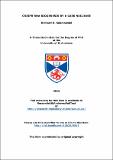Files in this item
CRISPR RNA biogenesis by a Cas6 nuclease
Item metadata
| dc.contributor.advisor | White, Malcolm F. | |
| dc.contributor.author | Sokolowski, Richard D. | |
| dc.coverage.spatial | 236 | en_US |
| dc.date.accessioned | 2015-06-24T11:56:50Z | |
| dc.date.available | 2015-06-24T11:56:50Z | |
| dc.date.issued | 2015-06-24 | |
| dc.identifier.uri | https://hdl.handle.net/10023/6861 | |
| dc.description.abstract | Clustered regularly interspaced short palindromic repeats (CRISPRs) and associated (Cas) proteins form the basis of a prokaryotic adaptive immune system. Acquired sections of viral DNA are stored within the host genome as ‘spacers’ flanked by ‘repeat’ sequences. The CRISPR arrays are transcribed and processed to release mature CRISPR RNAs (crRNAs) – containing a single, intact spacer sequence – that are used by effector complexes to base-pair with matching hostile genetic elements and silence future infections. crRNA-biogenesis is thus an essential step within the defence pathway. Within Type I and III systems, the primary processing of the CRISPR transcript at repeat sites is performed almost exclusively by the CRISPR-specific riboendonuclease, Cas6. This thesis seeks to probe the catalytic mechanism of a Cas6 enzyme from the crenarchaeon Sulfolobus solfataricus (sso). Despite analogous generation of crRNA, ssoCas6 paralogues differ from previously characterised Cas6 examples in their lack of a canonical active site histidine residue. The work here builds on recent crystallographic evidence that the ssoCas6-1 paralogue unexpectedly adopts a dimeric conformation (PDB 3ZFV, 4ILR), to show that not only is the ssoCas6-1 dimer stable in solution but that this atypical arrangement is important to the activity of this particular enzyme. Furthermore, the ssoCas6-1 paralogue is shown to be the first in this family of endonucleases to employ multiple-turnover kinetics. The widespread diversity in Cas6 catalytic mechanisms reflects the plastic nature of the Cas6 active site and rapid co-evolution with substrate repeat sequences. The CRISPR/Cas environment within S. solfataricus is highly complex, containing three co-existing system types (Type I-A, III-A, III-B), five Cas6 paralogues and two families of CRISPR loci (AB and CD) that differ by repeat sequence. By probing the activity of an additional ssoCas6 paralogue (ssoCas6-3), which reveals different substrate specificities to those of ssoCas6-1, evidence emerges for functional coupling between ssoCas6 paralogues and downstream effector complexes, sufficient to regulate crRNA uptake and possibly even complex assembly. | en_US |
| dc.language.iso | en | en_US |
| dc.publisher | University of St Andrews | |
| dc.subject | Sulfolobus solfataricus | en_US |
| dc.subject | CRISPR-Cas | en_US |
| dc.subject | Cas6 | en_US |
| dc.subject | Prokaryotic immune system | en_US |
| dc.subject | CRISPR-RNA (crRNA) | en_US |
| dc.subject | Antiviral defence | en_US |
| dc.subject | Endoribonuclease | en_US |
| dc.subject.lcc | QH434.S7 | |
| dc.subject.lcsh | Bacteria--Immunology--Genetic aspects | en_US |
| dc.subject.lcsh | Bacterial genetics | en_US |
| dc.subject.lcsh | RNA | en_US |
| dc.subject.lcsh | Endonucleases | en_US |
| dc.title | CRISPR RNA biogenesis by a Cas6 nuclease | en_US |
| dc.type | Thesis | en_US |
| dc.contributor.sponsor | Medical Research Council (MRC) | en_US |
| dc.type.qualificationlevel | Doctoral | en_US |
| dc.type.qualificationname | PhD Doctor of Philosophy | en_US |
| dc.publisher.institution | The University of St Andrews | en_US |
| dc.publisher.department | School of Biology | en_US |
This item appears in the following Collection(s)
Items in the St Andrews Research Repository are protected by copyright, with all rights reserved, unless otherwise indicated.

